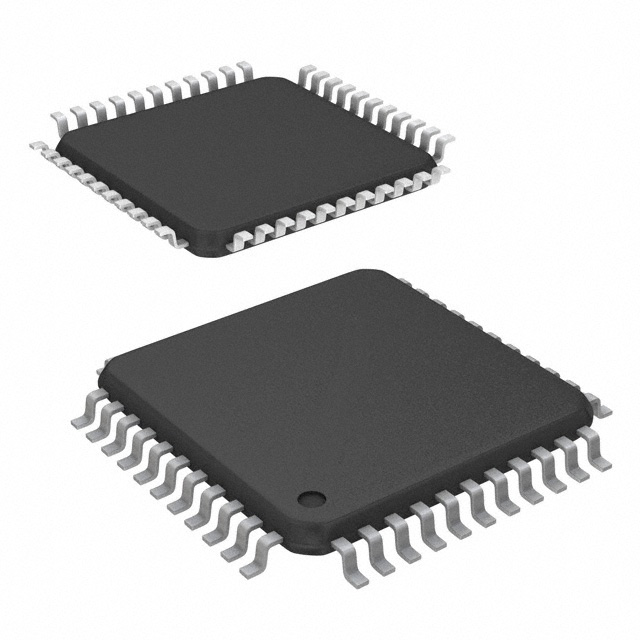Viz Specifikace pro podrobnosti o produktu.

ATMEGA323-8AC
Product Overview
Category
ATMEGA323-8AC belongs to the category of microcontrollers.
Use
It is commonly used in various electronic applications that require a microcontroller for processing and controlling functions.
Characteristics
- High-performance microcontroller with advanced features
- Low power consumption
- Wide operating voltage range
- Integrated peripherals for enhanced functionality
- Robust and reliable design
Package
ATMEGA323-8AC is available in a compact and durable package, suitable for easy integration into electronic circuits.
Essence
The essence of ATMEGA323-8AC lies in its ability to provide efficient processing and control capabilities in a wide range of electronic applications.
Packaging/Quantity
ATMEGA323-8AC is typically packaged in trays or reels, with varying quantities depending on the manufacturer's specifications.
Specifications
- Microcontroller architecture: AVR
- Operating voltage: 2.7V to 5.5V
- Flash memory: 32KB
- RAM: 2KB
- EEPROM: 1KB
- Number of I/O pins: 32
- Timers/counters: 3
- Analog-to-digital converter (ADC): 8 channels
- Communication interfaces: UART, SPI, I2C
- Clock speed: Up to 8MHz
Detailed Pin Configuration
The ATMEGA323-8AC microcontroller has a total of 40 pins, each serving a specific purpose. The pin configuration is as follows:
- Pins 1 to 20: Digital I/O pins (PA0 to PA7, PB0 to PB7)
- Pins 21 to 28: Analog input pins (ADC0 to ADC7)
- Pins 29 to 32: Ground (GND)
- Pins 33 to 36: Power supply (VCC)
- Pin 37: Reset (RESET)
- Pin 38: Crystal oscillator input (XTAL1)
- Pin 39: Crystal oscillator output (XTAL2)
- Pin 40: Voltage reference (AREF)
Functional Features
1. High-performance Processing
ATMEGA323-8AC offers a powerful processing capability, allowing for efficient execution of complex tasks.
2. Integrated Peripherals
The microcontroller is equipped with various integrated peripherals such as timers/counters, ADC, and communication interfaces, enabling seamless integration with external devices.
3. Low Power Consumption
ATMEGA323-8AC is designed to operate at low power levels, making it suitable for battery-powered applications.
4. Robust Design
With its robust design, the microcontroller can withstand harsh environmental conditions, ensuring reliable operation in demanding applications.
Advantages and Disadvantages
Advantages
- High-performance processing capability
- Integrated peripherals enhance functionality
- Low power consumption extends battery life
- Robust design ensures reliability
Disadvantages
- Limited memory capacity compared to some other microcontrollers
- Relatively higher cost compared to lower-end microcontrollers
Working Principles
ATMEGA323-8AC operates based on the AVR architecture, which utilizes a Harvard architecture with separate program and data memories. It executes instructions stored in the flash memory and interacts with external devices through its I/O pins and integrated peripherals.
Detailed Application Field Plans
ATMEGA323-8AC finds application in various fields, including but not limited to: - Industrial automation - Consumer electronics - Automotive systems - Medical devices - Internet of Things (IoT) applications
Detailed and Complete Alternative Models
Some alternative models that offer similar functionalities to ATMEGA323-8AC include: - ATMEGA16A - ATMEGA32A - ATMEGA64A - ATMEGA128A
These models provide varying memory capacities and additional features, allowing users to choose the most suitable microcontroller for their specific application requirements.
In conclusion, ATMEGA323-8AC is a high-performance microcontroller with integrated peripherals, low power consumption, and a robust design. It finds applications in various fields and has alternative models with different specifications to cater to diverse needs.
Seznam 10 běžných otázek a odpovědí souvisejících s aplikací ATMEGA323-8AC v technických řešeních
Sure! Here are 10 common questions and answers related to the application of ATMEGA323-8AC in technical solutions:
Q: What is ATMEGA323-8AC? A: ATMEGA323-8AC is a microcontroller from the AVR family, manufactured by Atmel. It has 32KB of flash memory, 2KB of SRAM, and various peripherals.
Q: What are the key features of ATMEGA323-8AC? A: Some key features include 32 general-purpose I/O pins, 8-channel 10-bit ADC, UART, SPI, I2C, timers/counters, and PWM outputs.
Q: What are the typical applications of ATMEGA323-8AC? A: ATMEGA323-8AC is commonly used in industrial automation, home automation, robotics, consumer electronics, and other embedded systems.
Q: How can I program ATMEGA323-8AC? A: You can program ATMEGA323-8AC using various programming languages like C or assembly. Popular development tools like Atmel Studio or Arduino IDE can be used.
Q: Can I use ATMEGA323-8AC for real-time applications? A: Yes, ATMEGA323-8AC can be used for real-time applications as it has built-in timers/counters and interrupt capabilities.
Q: What is the operating voltage range of ATMEGA323-8AC? A: The operating voltage range is typically 2.7V to 5.5V, making it compatible with a wide range of power supply options.
Q: Does ATMEGA323-8AC support communication protocols like I2C and SPI? A: Yes, ATMEGA323-8AC has built-in hardware support for I2C and SPI communication protocols.
Q: Can I interface ATMEGA323-8AC with external devices? A: Yes, ATMEGA323-8AC has multiple GPIO pins that can be used to interface with external devices like sensors, displays, motors, etc.
Q: Is ATMEGA323-8AC suitable for low-power applications? A: Yes, ATMEGA323-8AC offers various power-saving modes and features like sleep mode, idle mode, and power reduction registers.
Q: Are there any development boards available for ATMEGA323-8AC? A: Yes, there are development boards specifically designed for ATMEGA323-8AC, such as Arduino Mega or custom-made boards using the microcontroller.
Please note that these answers are general and may vary depending on specific requirements and implementations.

